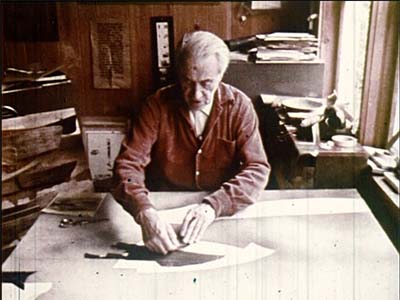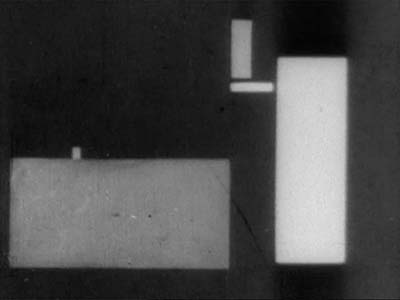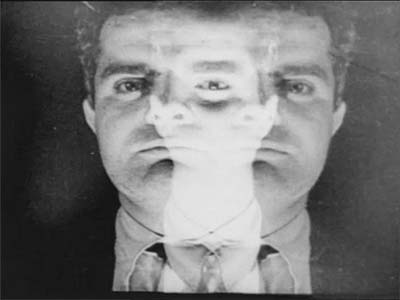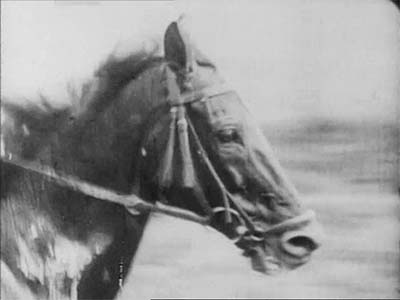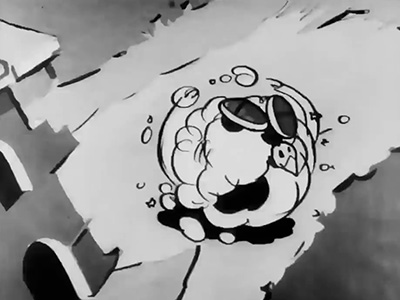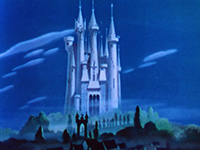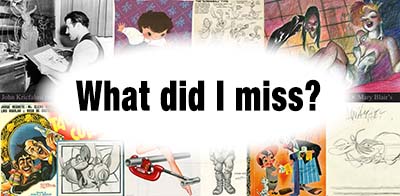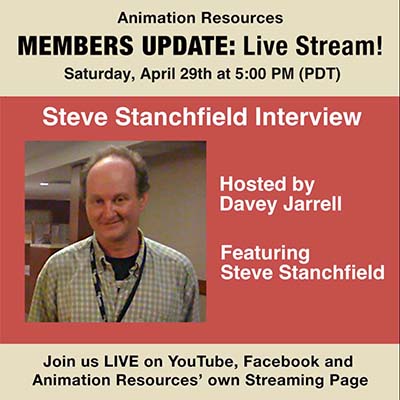People who aren’t members of Animation Resources don’t understand how comprehensive our Reference Packs are. Over the next couple of weeks, we will be posting what each section of our current RefPack looks like, starting today with the Featured section. If you are a member of Animation Resources, click on this post to go to the Members Only page. If you aren’t a member yet, today is the perfect time to join! Our current Reference Pack is one of our best yet, and General and Student Members get access to a special Bonus Archive with even more material from past Reference Packs.
What are you waiting for?![]()
JOIN TODAY!
https://animationresources.org/membership/levels/

Inspiration for animated films doesn’t just come from other animated films. A lot can be gained from exposing yourself to music, dance, live action cinema and fine art. Even architecture can be a useful area to study. Occasionally, we will share interdisciplinary inspiration here in the Side Trips section.
Four Films By Hans Richter
![]()
Rhythmus 21 (1921) / Ghosts For Breakfast (1927)
![]()
Inflation (1928) / Race Symphony (1928)
Download this article
Although Hans Richter may not be as well known as Salvador Dali, Piet Mondrian or Marcel Duchamp, he occupies as important a role in the history of the Dadaist and abstract movements in art. Between WWI and WWII, he explored abstraction as well as film making. In fact, his experimental film, “Rhytmus 21” was one of the very first abstract animated films.
He also made live action films following Dadaist principles, and pioneered sophisticated double exposure, opticals and montage techniques that would become standard in German expressionistic filmmaking a few years later.
In 1933, the Nazis destroyed Richter’s studio in Berlin in retaliation for his political stances, and he was branded a “degenerate” artist. A great deal of his work was destroyed, including the soundtrack to his Dadaist film, “Ghosts Before Breakfast” (1927).
We’re sharing several of his major films, along with an interview done with Richter in 1972. Listen carefully to what Richter says about filmmaking and its relationship to classical tradition of arts like drawing and painting, as well as his declaration that film is the “conscious articulation of time”.
These films may look primitive and technically crude today, but at the time they were made, they were groundbreaking. There was no precedent for these techniques. Richter describes the process of making experimental films in the early days as an “eerie experience” like walking into an empty room with no space. Throughout his life, Richter was a catalyst, always on the forefront facilitating revolutionary changes in art.
I conceive of the film as a modern art form particularly interesting to the sense of sight. Painting has its own peculiar problems and specific sensations, and so has the film. But there are also problems in which the dividing line is obliterated, or where the two infringe upon each other. More especially, the cinema can fulfill certain promises made by the ancient arts, in the realization of which painting and film become close neighbors and work together.
It’s clear that Richter thought like an animator.
MP4 Video File / 12:13 / 349 MB Download
MP4 Video File / 3:20 / 30 MB Download
MP4 Video File / 6:27 / 117 MB Download
MP4 Video File / 2:44 / 45 MB Download
MP4 Video File / 5:08 / 132 MB Download
JOIN TODAY To Access Members Only Content
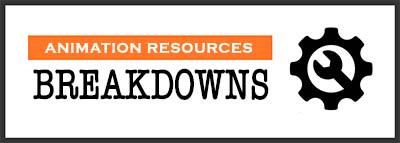
One of the most popular features of Animation Resources’ social media accounts is our breakdown clips. Animation Resources board member, David Eisman shares a handful of them in each Reference Pack, along with analysis of what you can learn from still framing through the animation.
Trucks & Pans
![]()
Curated By David Eisman
Download this article
In animation, there are three categories of camera moves: perspective turns, trucks, and pans. As perspective turns were discussed in Reference Pack 044, this article will focus on trucks, pans, and their variations. However, before these camera moves can be discussed in detail, they must be first defined in simplified terms. The truck, in essence, is the movement of a camera inward or outward. In live-action, this would be accomplished with a dolly, wherein a camera is mounted to an apparatus and pushed inward or outward along a track. The pan is the movement of a camera from side-to-side, either left to right or right to left. As for variations, there are multiple different types of trucks and pans. For the truck, there is the multiplane truck, manual truck, zoom, and multi-stage zoom. For the pan, there is the multiplane pan, single-plane pan, manual pan, and corkscrew pan.
There are crucial differences between a truck and a zoom. In a truck, there are changes in perspective. As the camera moves inward, planes of the environment move away from center-frame. Likewise, with a truck-out, the planes move toward center-frame. Additionally, the planes rotate according to the movement direction. In the case of a truck-in, the planes rotate toward camera, and rotate away from camera during a truck-out. In a zoom, none of these things happen. Instead, the scope of the frame changes. With a zoom, the frame goes from being either completely in-view or only partially in-view. There are no planar movements or rotations. Crucially, for a successful animated zoom, the frame, itself, must be several times larger than typical so that there is no loss of resolution.
The first two categories of truck that will be discussed are the multiplane truck and manual truck, demonstrated by Breakdown 04 and Breakdown 05 respectively. Breakdown 04 was generated by a multiplane camera, a specialized animation device where multiple separate planes are moved at different rates to simulate planar movement. However, the weakness of the multiplane camera is its inability to create planar rotation. The planes themselves are still images and, thus, cannot be rotated, only moved. The multiplane camera does allow for the planes to be moved at different rates, which helps to better simulate depth-of-field, accommodating for the lack of rotation. The farther away a plane is from camera, the slower it is supposed to move. This can be achieved either through differentiation of timing or spacing. In terms of timing, for instance, the plane closest to camera would move on 1s, while the one furthest could possibly move on 4s. However, since Breakdown 04 is entirely on 1s, the differentiation of rates is accomplished through variations in spacing. The closest planes have wide spacing, while the farther planes have tight spacing, with the exception of the furthest plane – the castle – which is entirely stationary. The other weakness of the multiplane truck is that, by its very nature, must be separated into a distinct number of individual planes. It is physically impossible to generate an infinite number of planes. Yet, in reality, a shrub three inches further back from a tree is a separate plane and moves and rotates at a different rate. In a multiplane truck, the shrub and tree would be part of the same plane due to their close proximity.
The manual truck, as showcased in Breakdown 05, has none of the weaknesses of the multiplane truck. Since the manual truck is just a series of sequential frames, it is completely possible to incorporate planar rotation as well as practically infinitesimally-small separations of the environment into distinct planes. The downside of the manual truck is that its successful generation is so difficult, it verges on the impossible. In the case of Breakdown 05, the complexity of the truck is bewildering, moving through radically different environments entirely on 1s with no stuttering or slipping. Moreover, the truck even incorporates moving animals. While Breakdown 05 is certainly impressive, it, like most of Richard William’s works, begs the question of purpose. It is unclear whether such a staggeringly difficult shot actually improved the quality of the scene. While animators are sure to gawk in stunned amazement, the uninformed viewer will neither care nor understand the magnitude of the work that was required to achieve such a camera movement.
The manual pan, the counterpart to the manual truck, has remained elusive. Perhaps once such a camera move is located, an addendum to this article will be released. However, the manual pan can still be speculated upon as to how it would operate. Like the manual truck, the hypothetical manual pan would have planar rotation. However, the planes would rotate either to the left or right as opposed to away or toward camera. For pan-right, the planes would rotate to the left, and for pan-left, the planes would rotate to the right.
Breakdown 01 and Breakdown 02 demonstrate one of the most common types of pans, the multiplane pan. Like Breakdown 04, the environment is separated into distinct still images that are moved at different rates to create depth-of-field. Moreover, like Breakdown 04, both Breakdown 01 and Breakdown 02 choose to generate different rates through varied spacing rather than timing. Obviously, Breakdown 01 is a much more complicated shot, with more planes as well as characters articulating as they move through the shot. However, Breakdown 02 generates a more convincing depth-of-field than Breakdown 01, since the differentiation of movement rates between the planes is more clear, with the furthest planes moving slower than the closest. In Breakdown 01, the planes move at essentially the same speed.
Aside from the multiplane pan, there is, of course, a single-plane pan, where a single still image much longer than the scope of the camera is moved alongside a horizontal access. Sometimes, the plane itself is wildly complex. For instance, the plane may have trees in the foreground, telephone poles in the midground, and skyscrapers in the background. However, since that aforementioned image is a single plane, it is impossible for the foreground, midground, and background to move at different rates like they could in a multiplane pan. Thus, the camera move does not create depth-of-field and simply looks like a still image being dragged from left to right or vice-versa.
Breakdown 06 is an example of a multi-stage zoom, a more complex version of the basic zoom described earlier in the article. A multi-stage zoom is where the camera zooms in on one large image. That image is then replaced with a new frame so that the zoom can proceed. In Breakdown 06, the frame is swapped with a new background at frame 30, 40, 62, 78, and 97. While this replacement process does allow for a longer zoom, it creates a distracting stutter effect that feels more like a mistake than deliberate operation.
Finally, Breakdown 03 is an entirely different type of camera move called a corkscrew pan, where the camera spins. This particular pan has several purposes in this scene. For one, it is humorous and fits the jovial, ridiculous tone. Additionally, it hides the transition where the two characters swap clothing and then eventually body parts. The background is a single still image being spun around, while the foreground characters are animated frame-by-frame. While the corkscrew pan is certainly unique and fun, it must be implemented with purpose and not just thrown into a scene for the sake of random chaos.
Ultimately, trucks and pans are as elaborate and complicated as perspective turns, just in different ways. They can be generated frame-by-frame or through the manipulation of still images. Regardless, no one form of truck or pan is better than the other. It is simply a matter of which method fits the scene better.
Breakdown 51-01: “The Caveman” (Iwerks / 1934)
Breakdown 51-02: “Icarus” (Paul Bochner / 1974)
Breakdown 51-03: “Swing You Sinners” (Fleischer / 1930)
Breakdown 51-04: “Cinderella” (Disney / 1950)
Breakdown 51-05: “Thief and the Cobbler” (Richard Williams / 1993)
JOIN TODAY To Access Members Only Content
Animation Resources is one of the best kept secrets in the world of cartooning. Every month, we sponsor a program of interest to artists, and every other month, we share a book and up to an hour of rare animation with our members. If you are a creative person interested in the fields of animation, cartooning or illustration, you should be a member of Animation Resources!
It’s easy to join Animation Resources. Just click on this link and you can sign up right now online…
JOIN TODAY!
https://animationresources.org/membership/levels/
![]()
![]() Animation Resources depends on your contributions to support its projects. Even if you can’t afford to join our group right now, please click the button below to donate whatever you can afford using PayPal.
Animation Resources depends on your contributions to support its projects. Even if you can’t afford to join our group right now, please click the button below to donate whatever you can afford using PayPal.














